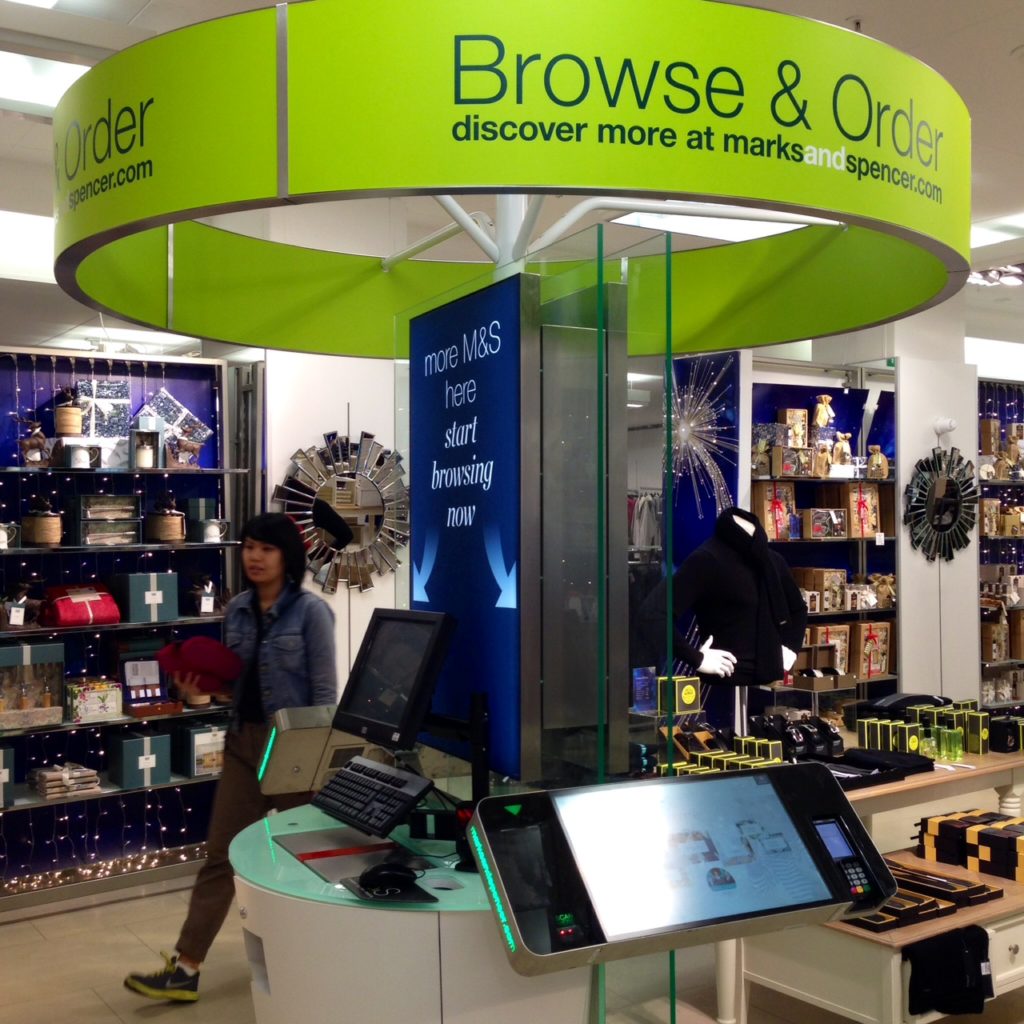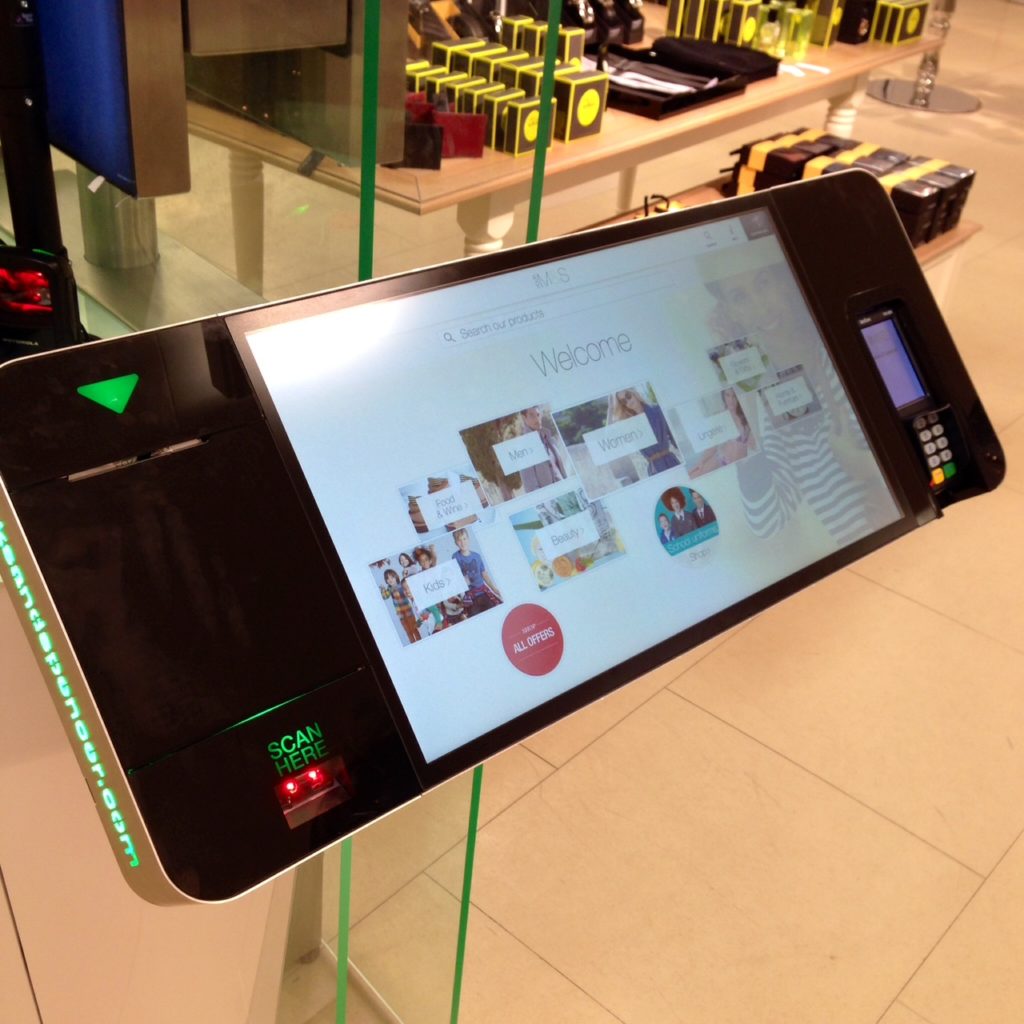Online Interaction In Situ
I’d heard that Marks and Spencer had some interesting computing set ups in some stores, so I was keeping my eyes open for them I finally stumbled across one yesterday.
It’s quite something. It’s three stations; one, a proper workstation, very slightly reconstructed to function as a pubic terminal (in the middle, with the attached keyboard), and two computers set up to look like giant iphones. Giant iphones on which you can a) scan through everything you can buy from M&S, which is a lot, b) scan the barcode of a product you have in hand at the store, and b) order products and pay for them on the device using your credit card.
What M&S is doing here is pretty analogous to what we do with computing in libraries; there is a collection all around you, but you can access it digitally as well. And, with the barcode reader, the two can interact.These are custom computing devices to help branch the physical and the digital world, and nicely-thought out ones at that. When I first saw it, I wondered if they were trying to highlight the fact that you don’t actually need to come into the store, you can order everything you want online and have it delivered, but I think it’s more than that. It’s offering a new dimension of service to people who are physically in the building.
I haven’t yet seen libraries branch into shifting the metaphor from sitting down at a workstation to an app-like experience like you see here. It might be too early for the general population, but I can’t see why you wouldn’t try, and why it wouldn’t work. Look at the difference between the set ups; the keyboard and mouse seem so clunky next to the slick faux-iphone. I flipped through the options a bit on the touch screen while I was there, and it was very much like scanning through a paper catalogue. It’s a jump ahead in that it’s bringing the digital version of the shop into the physical shop, but it’s also a return to the paper catalogue, just in digital form, with the ability to order without looking away from it. That seems really accessible to me.
I’m always interested in how well-considered technology like this works on the ground, and unfortunately I didn’t manage to witness anyone trying to use these. (I might have to go back and watch.) What’s really nice about them is how really approachable they are; it would certainly be easier to use the touch device with a friend or a staff member than the keyboard and mouse set up. It’s lower, it’s pointing up at you, it’s got smooth, broad edges so that people can gather around it. The screen is bigger. The software is clear, simple, and beautiful. It’s not the same thing as a regular computer. It barely feels like a computer at all, in the same way that a phone is a phone in our minds, not a computer. Would something like this have a place in a library?
We’d have to consider what it’s for. Because it’s not a generic computer that a patron could use for whatever they like, the purpose and use has to be crystal clear. Is it for browsing the collection? Is that a short-term activity, or a longer-term one? These computers are set up primarily for people who know what they’re looking for and want to find/order it. They even appear to be for people who have an item in hand and want to order a variation of it. It’s a very specific need that’s filled here. (You could browse the whole collection here as well, conceivably, but isn’t that better done at home sitting on the couch?) Libraries definitely have their specific-need patrons as well; reserve materials, textbooks, looking for a specific book or article. Is something like this helpful? We certainly have a lot of computers in libraries. The way these ones are set up, they don’t let people convert them into email-checking machines. They’re single-purpose; browsing and ordering from the collection. That’s all.
Though, when you think about it: it would be interesting if a device in a library could be a springboard off of I want something like this. Scan a LC call number or a barcode and see everything in that narrow band for browsing. That might be a way to help incorporate our digital materials into a physical space. Physical books would then act as placeholders, the beginning of a journey into the physical and the digital at once. A reference collection could even double as the show collection, really (since it’s a miniature version). Patrons could bring their own books in, too. Or you could type in a title, I suppose, as you can do at these M&S terminals. It’s like a variation on a search term, like searching via photograph. Search via book metadata, without ever really knowing what that metadata is. I want more like this. That’s sort of interesting.
It’s a cross-over between what can physically sit in a building and what’s available. I found this set up in M&S next to the underpants section. If you found a pair of underpants or a bra you liked but wasn’t in your size, you could order what you wanted directly from the computers here. It’s hard to say where that’s heading, really. Will people go for that? Will they eventually discover that they can do without the physical analogue as a starting point? (It seems, largely, that that’s what’s happening: online shopping statistics seem to go up and up and up every year.) What’s the future of shops like this? At the moment, this department store is still pretty crowded, and these digital ports were untouched while I was there. I’m not entirely sure it’s found it’s niche in this case. But I didn’t get to see it in use with a member of the staff. It might be that they walk customers through this when they have their heart set on something that isn’t in stock.
These two kinds of computing stations is, it seems to me, a physical manifestation of where we are at the moment when it comes to computing; the keyboard and mouse are slowly being replaced by something slicker, but not everyone’s entirely ready for it. In fact, most people aren’t; look at the signage over the standard monitor. It looks as if they put the fancy iphone-like devices in, but people kept drifting toward the keyboard and mouse instead. So they had to highlight that you can get the same content from the computers on either side as well! When the first laptop came out without a floppy drive, it hurt, because floppy drives were still in use. But eventually no computer had one anymore. This feels like one of those moments. The keyboard-and-mouse metaphor, which is frankly quite difficult to understand since both are proxies (press a button to create a letter that builds words, move an object to move a arrow that stands in your finger), is so comfortable and familiar to us that we often prefer it even though it’s far more primitive. But I suspect that will ease off as we fall more and more in love with our smartphones. I think dressing that touchscreen up as a smartphone was a good idea, as it helps replace that keyboard metaphor with something equally ground into our consciousness.
I think commercial experiments like this have a lot of teach us in libraries. I’m going to keep my eyes open for more of these.


0 thoughts on “Online Interaction In Situ”
Yesterday’s cool discovery: the giant iPhones of M&S http://t.co/qIq3Q27zi9
RT @rmazar: Yesterday’s cool discovery: the giant iPhones of M&S http://t.co/qIq3Q27zi9